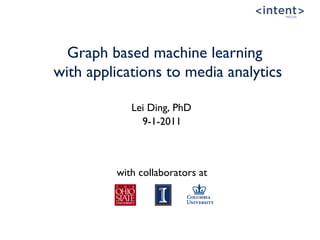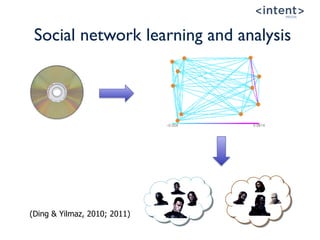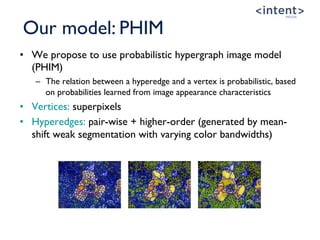Ad
Graph Based Machine Learning with Applications to Media Analytics
- 1. Graph based machine learning with applications to media analytics Lei Ding, PhD 9-1-2011 with collaborators at
- 2. Outline • Graph based machine learning – Basic structures – Algorithms – Examples • Applications in media analytics – Social analysis of videos – Content analysis of images
- 3. Outline • Graph based machine learning – Basic structures – Algorithms – Examples • Applications in media analytics – Social analysis of videos – Content analysis of images
- 4. What is a graph Not the graph we are going to talk about
- 5. What is a graph • A graph is composed of – Vertices (nodes): pixels, actors in videos, genes, ads, etc. – Edges: their relations – In machine learning, we are interested in predicting some quantity (a class label, or a continuous value) at each unlabeled vertex
- 6. What is a graph • A graph is composed of – Vertices (nodes): pixels, actors in videos, genes, ads, etc. – Edges: their relations – In machine learning, we are interested in predicting some quantity (a class label, or a continuous value) at each unlabeled vertex • Broadly speaking, there are two kinds of graphs undirected directed
- 7. Graph based machine learning for media analytics • Oftentimes, media content can be represented using graphs • Therefore, challenging inference problems with media content can be answered by learning on graphs
- 8. Social content model Content network encodes content similarity (videos, audios, etc.) Content generation process Social network encodes peoples’ social connections Can be used for media genre classification, media recommendation, etc.
- 9. Graph based machine learning • On undirected graphs – Optimization based approaches (e.g. energy minimization) – Probabilistic models (e.g. random fields) • On directed graphs – Optimization based approaches (e.g. directed energy minimization) – Probabilistic models (e.g. latent Dirichlet allocation, Bayesian networks)
- 10. Relations • How are they related to traditional stats learning (e.g. logistic regression) (Sutton McCallum, 2007)
- 11. Graph based machine learning • On undirected graphs – Optimization based approaches (e.g. energy minimization) – Probabilistic models (e.g. random fields) • On directed graphs – Optimization based approaches (e.g. directed energy minimization) – Probabilistic models (e.g. latent Dirichlet allocation, Bayesian networks)
- 12. Learning on undirected graphs • Classification methods – We have some labeled data, and want to predict labels for others – e.g. manifold regularization • Clustering methods – We would like to partition data into clusters – e.g. spectral clustering
- 13. Constructing data graphs • How to transform a dataset ({xi}, i=1..m) into a graph
- 14. Affinity matrix • A graph is usually represented using an affinity matrix W, where the corresponding entry is 1 if two vertices are connected, and 0 otherwise
- 15. Graph Laplacians • L=D-W, where W is an affinity matrix, D is a diagonal matrix of row sums • Discretization of Laplace-Beltrami operator on manifolds, which is the sum of second order derivatives on tangent space (more details later)
- 16. Function on graph • A vector can be used to represent a function over the graph – We can encode what we already know or what we want to predict in a label function – For example in this graph, a vertex can represent a person, and the function can represent if he is a likely customer 0 1 1 1 0 0 f = [ 1, 1, 0, 0, 1, 0 ] T
- 18. Properties of graph Laplacians • Symmetric and positive semi-definite • Graph Laplacian induces a smoothness term – Transposed label function f * Laplacian matrix L * label function f (always non-negative) – Smoothness term (fTLf) measures how much the function f varies with respect to the underlying graph – We have labels on some vertices, and want to predict labels on other vertices. A smooth function (small fTLf) typically predicts well • Laplacian eigenvectors with small eigenvalues can be used for data clustering / classification, data set parametrization, image segmentation, etc.
- 19. Properties of graph Laplacians • Symmetric and positive semi-definite • Graph Laplacian induces a smoothness term – Transposed label function f * Laplacian matrix L * label function f (always non-negative) – Smoothness term (fTLf) measures how much the function f varies with respect to the underlying graph – We have labels on some vertices, and want to predict labels on other vertices. A smooth function (small fTLf) typically predicts well • Laplacian eigenvectors with small eigenvalues can be used for data clustering / classification, data set parametrization, image segmentation, etc. Now we are ready to see the algorithms, but let’s take a little break to understand things even further
- 20. Manifolds
- 21. Manifold perspective of data modeling
- 22. Why graphs encode underlying data geometry If we consider data as samples from an underlying manifold (which is a fairly weak assumption), and construct the corresponding adjacency graph, then eigenvectors of graph Laplacian approximate eigenfunctions of the Laplace-Beltrami operator of the underlying data manifold (Belkin Niyogi, 2008)
- 23. Laplacian eigenvectors “understand” geometry (Rustamov, 2007)
- 24. Spectral clustering More information in von Luxburg (2007)
- 25. Spectral clustering explained • Why the eigenvectors of L with small eigenvalues are used as the new representation? • The minimizers fi for the following total smoothness term are eigenvectors of L with the smallest eigenvalues
- 26. Results
- 27. Laplacian eigenmap • Using Laplacian eigenvectors with the smallest eigenvalues as the new representation • Can be seen as a non-linear extension of PCA (Belkin Niyogi, 2003)
- 28. Results on real data • Transform data using Laplacian eigenmap, and use linear regression on the new representation (Belkin Niyogi, 2004)
- 29. Manifold regularization • A comprehensive regularization framework • Through applying the representer theorem in functional analysis, the optimal solution is as follows (Belkin et al., 2006)
- 30. Results on real data (Belkin et al., 2006)
- 31. Summary • Learning on graphs provides a set of powerful techniques for data analysis and predictive analytics that “understand” the geometry of underlying data • Spectral clustering – addresses the limitation with traditional K-means • Laplacian eigenmap manifold regularization – learn a label function respecting underlying data geometry, and hence provide benefits over standard methods like PCA and linear regression • Lots of other approaches as well – will talk about label propagation based on graphs later in this presentation
- 32. Outline • Graph based machine learning – Basic structures – Algorithms – Examples • Applications in media analytics – Social analysis of videos – Content analysis of images
- 33. Applications in media analytics High-level analysis Social relational inference People to communities Mid-level analysis Event detection Visual features to events Low-level analysis Segmentation Pixels to semantic objects
- 34. Application 1: social analysis of multimedia data Friends or foes? Acquaintances or strangers? In same or different teams?
- 35. Social network learning and analysis
- 36. Social network learning and analysis
- 37. Social network learning and analysis (Ding Yilmaz, 2010; 2011)
- 38. Application areas • Social content: given the growing popularity of social media, inferring relations among people is becoming important • Visual recognition: social context is shown to help improve recognition results from images (e.g. Wang et al., ECCV 10) • Surveillance: social network learning and analysis for surveillance applications (e.g. Yu et al., CVPR 2009) • Sociology: necessary step in building intelligent systems for aiding sociological discovery
- 39. Basic video processing • Videos segmented into semantic segments – Scenes, or visually coherent sets of shots, for movies and TV shows – Shot detection and merging based on key-frame similarity (Rasheed Shah, 03) • Identifying the actors appearing in each segment – Using scripts and closed captions for movies – Face detection and recognition for other videos
- 41. Overall process Social Relations video-level A number [-1,+1] for each scene: positive if actors in a scene are likely in the same Grouping cues community, negative if otherwise scene-level Estimate the likely events in a scene Event estimates Dynamic systems represent scenes Scene models Feature observations frame-level
- 42. Key steps
- 43. Visual features • Generic optical flow orientation histogram
- 45. Using visual concepts • Visual concept detection provides useful semantic features for inferring social relations • Using Columbia s 374 SVM concept detectors on color/texture/edge features, a concept score vector is generated for each scene
- 46. Evidence synthesis by Gaussian processes
- 47. Learned social affinity — Learned social network is represented by affinity matrix K
- 49. RACOM dataset • Ten example movies: (1) G.I. Joe: The Rise of Cobra (2009); (2) Harry Potter and the Half-Blood Prince (2009); (3) Public Enemies (2009); (4) Troy (2004); (5) Braveheart (1995); (6) Year One (2009); (7) Coraline (2009); (8) True Lies (1994); (9) The Chronicles of Narnia: The Lion, the Witch and the Wardrobe (2005); (10) The Lord of the Rings: The Return of the King (2003) .
- 50. Analyzing social networks • We extend the max-min modularity principle such that it works with the learned social networks, in order to detect the two communities for each movie • We also identify the leaders of each community, which interestingly, correspond to the hero/villain most of the time
- 52. Visual maps
- 55. Youtube dataset • 10 videos for soccer games; 10 videos for demonstration; • The goal here is to predict a grouping cue for each scene. We evaluate against ground truth labeling
- 56. Youtube results • Event categories are considered and labeled in a middle step – Soccer: (chasing, confronting, hugging, others) – Demonstration: (marching, confronting, public speaking, others) • Precision (+) for within-community instances and Precision (-) for across- community instances are reported separately
- 57. Application 2: image content analysis • Interactive whole-object segmentation – Inputs: an image labeled pixels (seeds) for objects/background – Outputs: labels for all other pixels (Ding Yilmaz, 2010)
- 58. Overview • To segment whole objects from images given user-supplied seeds – Different from unsupervised segmentation from a single image, which typically generates homogeneous regions – The challenge is to segment objects using a small number of seeds • In addressing this problem, we have proposed – Probabilistic hypergraph image model (PHIM) – Automatic label set augmentation using boundary features – Multiple view learning synthesizing features
- 59. Graphs vs. hypergraphs • Graph based approaches have been popular for interactive segmentation – Graph cut (Rother et al., 2004) – Random walk (Grady, 2006) • Hypergraphs vs. graphs for images – Higher order relations among pixels that tend to form a segment are encoded as hyperedges, which are collections of vertices – Model long-range dependencies among the entities (known and unknown labels)
- 60. Our model: PHIM • We propose to use probabilistic hypergraph image model (PHIM) – The relation between a hyperedge and a vertex is probabilistic, based on probabilities learned from image appearance characteristics • Vertices: superpixels • Hyperedges: pair-wise + higher-order (generated by mean- shift weak segmentation with varying color bandwidths)
- 61. Our model: PHIM (cont’d) • Feature vector Fs of a superpixel s contains average LUV color values • Incidences: kernel density estimator taking superpixel features as the input • Hyperedge weights: inhomogeneous hyperedges are down-weighted – Reduces to standard graph based edge weights when the hyperedge is of size 2
- 62. Laplacians on PHIM • Normalized Laplacians on PHIM: induced quadratic form measures the smoothness of a function with respect to the underlying edge system – We use probabilistic incidences (hv,e) in defining Laplacians on PHIM • Notations – f: vector of function values on vertices (+1 for object; -1 for background) – H: probabilistic incidence matrix; W: hyperedge weight matrix – De: hyperedge degree matrix; Dv: vertex degree matrix
- 63. How to do segmentation • Constrained smoothness minimization – Essentially an interpolation, as we have confidence in user-supplied segment labels • This interpolation can also be solved in an iterative manner using the natural random walk
- 64. Dataset • GrabCut dataset of 50 images (Rother et al., 2004) • Seed pixels are provided in the form of trimaps • Ground-truth segmentations are supplied
- 65. Results on segmentation • Error rates averaged over the GrabCut dataset of 50 images – PHIM performs better than a standard graph – Our error rate 5.33% is much better than 7.9% achieved in (Blake et al., 2006), and is comparable to state-of-the-art results from pixel-level optimization
- 67. The end • Thanks! • References – Ulrike von Luxburg, A Tutorial on Spectral Clustering, 2007 – Charles Sutton and Andrew McCallum, An Introduction to Conditional Random Fields for Relational Learning, 2007 – Raif Rustamov, Laplace-Beltrami Eigenfunctions for Deformation Invariant Shape Representation, 2007 – Mikhail Belkin and Partha Niyogi, Laplacian Eigenmaps for Dimensionality Reduction and Data Representation, 2003 – Mikhail Belkin and Partha Niyogi, Semi-Supervised Learning on Riemannian Manifolds, 2004 – Mikhail Belkin, Partha Niyogi and Vikas Sindwani, Manifold Regularization: A Geometric Framework for Learning from Labeled and Unlabeled Examples, 2006 – Mikhail Belkin and Partha Niyogi, Convergence of Laplacian Eigenmaps, 2008 – Lei Ding and Alper Yilmaz, Learning Relations Among Movie Characters: A Social Network Perspective, 2010 – Lei Ding and Alper Yilmaz, Interactive Image Segmentation Using Probabilistic Hypergraphs, 2010 – Lei Ding and Alper Yilmaz, Inferring Social Relations from Visual Concepts, 2011
















![Function on graph
• A vector can be used to represent a function over the graph
– We can encode what we already know or what we want to predict in a
label function
– For example in this graph, a vertex can represent a person, and the
function can represent if he is a likely customer
0 1
1
1
0
0
f = [ 1, 1, 0, 0, 1, 0 ] T](https://image.slidesharecdn.com/graphbasedmachinelearning-110908103202-phpapp02/85/Graph-Based-Machine-Learning-with-Applications-to-Media-Analytics-16-320.jpg)
























![Overall process
Social Relations video-level
A number [-1,+1] for each scene: positive
if actors in a scene are likely in the same Grouping cues
community, negative if otherwise
scene-level
Estimate the likely events in a scene
Event estimates
Dynamic systems represent scenes
Scene models
Feature observations frame-level](https://image.slidesharecdn.com/graphbasedmachinelearning-110908103202-phpapp02/85/Graph-Based-Machine-Learning-with-Applications-to-Media-Analytics-41-320.jpg)


























































































































